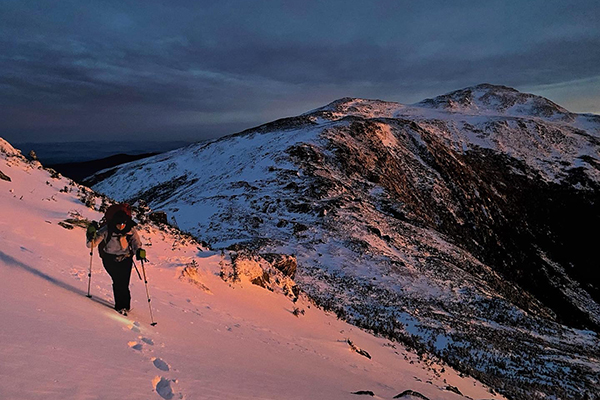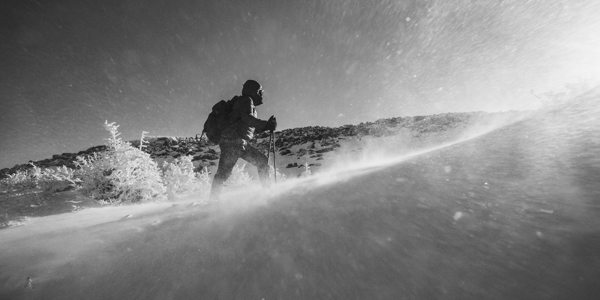
Presidential Traverse in Winter
So you’re ready for New England's single biggest mountaineering challenge? If you are looking for an all-out winter mountaineering experience, look no further. The presidential traverse is over 20 miles long and crests 9 major peaks over 4,000ft and several sub-peaks. The majority of the climb is above tree line, exposing participants to snow, sleet, and of course the White Mountains’ notorious winds. You can expect long days in high winds, white outs, below zero temperatures, and precipitation of all kinds. Participants must be experienced with crampon techniques, self-arrest, and be in terrific physical condition.
IMPORTANT BETA
CLIMB DETAILS
Length: 3 Days
Guide-to-Client Ratio: 1:3
Difficulty: Strenuous
When: December - April
Type: Mountaineering
Type: Experiential
STANDARD PRICING
1 person: $1250 per person
2 people: $950 per person
3 people: $800 per person
4 people: $750 per person
Group & private rates available
WEATHER WINDOW
The presidential traverse requires a perfect weather window to be successful. We book 3 days so that we can shift the itinerary to fit. You can expect one day of preparation, two days of climbing with one night in the mountains.
RENTAL GEAR
Most of the required equipment [listed below] is available for rent from our affiliate mtnGEAR. NEM climbers will receive an exclusive discount of 20% discount on all rental equipment and clothing.
BE INFORMED. BE PREPARED.
Itinerary
Presidential Traverse in Winter
- Day 1 will be spent doing a gear check, car spotting and securing any necessary supplies
- Day 2 we begin the traverse and spend the night at RMC Grey Knob Hut.
- Day 3 sees big miles across the remaining peaks to the Highland Center in Crawford Notch
- Pick up cars and return to The Bunkhouse upon completion
Skill Set Required
The Presidential Traverse in winter is a serious undertaking. You should be in terrific physical condition, familiar with your gear and have previous winter hiking experience. This is a terrific challenge that minimizes the amount of time available for education.
- Must have previous winter hiking and camping experience
- Crampon techniques for ascending, descending and snow travel
- Basic self arrest
- Basic rappelling techniques
- Familiar with Avalanche Beacons, Probes and protocol
What To Wear
PLEASE BRING THESE ITEMS WITH YOU FROM HOME
When selecting clothing for your adventure, think layers. Choose synthetic materials, wool, or fleece.
The saying is "Cotton Kills." It will absorb sweat and then freeze - increasing the chances of hypothermia.
Please Bring the Following Items. |
Guides Pick |
| [ ] Base Layer Top and Bottom: Long-sleeve wool or synthetic top will be used as your base layer. Zip-neck styles will allow for better temperature regulation. | Smartwool Men's NTS Mid 250 Top Smartwool Men's NTS Mid 250 Bottom Smartwool Women's NTS Mid 250 Top Smartwool Women's NTS Mid 250 Bottom |
| [ ] Socks Wool or Synthetic | Darn Tough |
Snow pants will suffice instead of soft shell climbing pants and if you have insulating layers and jackets we recommend that you bring them. There will be time to sort through what you should bring and what you leave behind.
Mandatory Gear List
RENTALS AVAILABLE AT CLIMBINGRENTALS.COM
Most of the required equipment [listed below] is available for rent from our affiliate mtnGEAR.
NEM climbers will receive an exclusive discount of 20% discount on all rental equipment and clothing.
Mandatory Items |
Guides Pick |
| [ ] Pack with Waist Strap: A 30-40L pack is the recommended size for one day climbs. Your pack MUST have a waist strap. A backpack will not suffice. | Hyperlite Mt Gear - 2400 Ice Pack |
| [ ] Crampons: 10-12 point adjustable crampons designed for mountaineering | Black Diamond Contact |
| [ ] Ice Axe: An ice axe designed for general mountaineering. | Black Diamond Raven Pro |
| [ ] Helmet: A lightweight climbing helmet. | Petzl Sirocco |
| [ ] Warm Hat: Wool or synthetic. It should be warm and thin enough to fit underneath a climbing helmet. | OR Gradient Hat |
| [ ] Buff/Neck Gaiter: Buff makes the best option. | Buff Merino Wool |
| [ ] Ball Hat/Sun Hat: Optional. A lightweight ball cap or sun hat. | |
| [ ] Sun Glasses: A pair of dark-lensed sunglasses with side shields or full wrap-type sunglasses. | Julbo Tamang |
| [ ] Lightweight glove: One pair of fleece gloves. | OR Sensor OR Catalyzer [W] |
| [ ] Medium Weight Glove: Wind/water resistant insulated mountain gloves. | OR Ambit OR Ambit [W] |
| [ ] Heavy Insulated Mitten: Wind/water resistant, insulated mittens for protection against wind, snow and cold. These also serve as emergency back-ups if you drop or lose a glove. | OR High Camp OR Highcamp [W] |
| [ ] Light Insulating Layer/Soft Shell Top: A fleece or other insulation layer. | Arcteryx Gamma MX Hoody Arcteryx Gamma MX Hoody [W] |
| [ ]Hard Shell Jacket with Hood: Wind/rain Proof. Gore-Tex recommended. | Arcteryx Beta LT Arcteryx Beta SL [W] |
| [ ] Insulated Parka: This item becomes of highest importance when we are faced with poor weather. This should be an expeditionary-type heavy parka that extends well below the waist and above the knees. Goose down is recommended versus synthetic fill. It does not have to be waterproof, but that is a nice feature. The parka is worn primarily at rest breaks on summit day and as an emergency garment if needed. When sizing a parka, allow for several layers to be worn underneath; buy it large. The parka must have an insulated hood. | OR Incandescent Arcteryx Cerium LT [W] |
| [ ] Climbing Pants: Synthetic climbing pants offer a wide range of versatility. You can wear them alone on hot days, or in combination with the base layer on cold days. The thickness (insulation quality) should be based on how well you do in the cold. For most of our adventures snow pants will suffice. | Mountain Hardwear Chockstone Arcteryx Gamma AR [W] |
| [ ] Hard Shell Pants: A pant made of breathable rain and wind-proof material will be needed. Full-length side zippers are required for facilitating quick clothing adjustments over boots and crampons in cold, inclement weather. | Marmot Precip Full Zip Marmot Precip Full Zip [W] |
| [ ] Mountaineering Boots: Insulated plastic boots are the preferred choice for winter mountaineering. They provide the best insulation as well as a more rigid sole for kicking steps and holding crampons. Leather mountaineering boots that have completely rigid soles are also adequate, but they will need to be insulated and may still result in cold feet above treeline. Lightweight hiking boots without insulation are not acceptable as they don’t work well with crampons, or in very cold or wet weather. Winter boots are not acceptable unless they adequately hold a crampon. Check out A Guides View: Selecting Mountaineering Boots. | La Sportiva Batura Lowa Weisshorn GTX [W] |
| [ ] Gaiters: A knee-length pair of gaiters, large enough to fit over your mountaineering boots. This will protect you from catching your crampons on loose clothing. | OR Crocodiles OR Crocodiles [W] |
Overnight Items |
Guides Pick |
| [ ] Foam Sleeping Pad | Thermarest Ridgerest Solite |
| [ ] Blow Up Sleeping Pad | Sea To Summit Ultralight |
| [ ] -10 Sleeping Bag Down or Synthetic. | Sea To Summit Alpine III |
Nutrition & Hydration
Nutrition
It is important to continuously take in calories throughout the day. Every break you should eat a snack during the short 10 to 15 minute rest. Food is the wood to your fire and to keep it stoked it needs constant replenishing. Do not plan on cooking or preparing your snacks in the field. All food should be prepared and packed ready for immediate consumption.
We suggest crackers, pizza, candy bars, jerky, chips, cookies, trail mix, fruits, Gu, energy bars, and hard candies. Add peanut butter, cream cheese, hard cheese, or pepperoni for additional calories and taste. If you enjoy bread items, bagels work well. Include some salty snacks to replenish lost salts.
Hydration
To help prevent cramping and heat related injuries, you will need at least 2 liters of water per day. Water is preferred, but other liquids such as gatorade help replace electrolytes and work well, too! Hydration bladders do not work as they freeze during the winter months. Please leave these at home. Instead, bring 32oz. Wide Mouth Nalgene bottles and insulating parkas if you have them. If not, you can use a sock to insulate each water bottle.
FAQ's
Do I need any prior experience?
Yes! The Presidential is a serious undertaking for any experienced mountaineer. Participants should be terrific physical shape and have winter hiking and camping experience. The weather above treeline can be extreme and participants should be prepared for exposure to high winds and arctic temperatures. We will work hard to ensure your safety, teach you the necessary skills and keep the excitement level high!
What happens if the weather doesn't cooperate?
We usually will go out in the rain and snow. Lightning will reschedule or end our course. Please plan for all weather conditions. We may just alter the plan based on the weather forecast.
Am I supposed to tip my guide(s)?
Tips are never expected, however if you think your guide did a great job, tips are welcomed and appreciated. A normal tip is 20% of the guide fees or $20 per guide per day.
Can I rent the gear that I do not own?
Most of the required equipment is available for rent from our affiliate mtnGEAR. NEM climbers will receive an exclusive discount of 20% discount on all rental equipment and clothing.
What are 'Mountaineering Boots'?
These are boots that are designed specifically for snow and very cold weather. They are often composed of an internal insulating boot and an exterior plastic or leather boot. Hiking boots and winter snow boots are not suitable for Mt. Washington or the high peaks of New England in the winter.
Where should I stay?
We recommend The Bunkhouse at Northeast Mountaineering. For your convenience, we offer co-ed, hostel-style accommodations on site. The cost is $45 per person. To maximize your climbing experience, we recommend that you stay in the area the night before your climb. During the traverse, we will stay at the AMC Grey Knob Hut.
How do I find out when and where to meet?
Upon completion of your registration you will get a confirmation email with a link to all the pertinent information. You will be asked to secure your rental equipment and read through the welcome information to be prepared and on time for your course.
Not Ready? Try your hand on Mount Washington. Still not sure? Contact Us for a recommendation.

WHEN THINGS DO NOT WORK OUT, WE GO TO PLAN B
Because the Presidential Traverse is primarily above tree line and exposed to the elements, there are times when the conditions do not permit a full traverse. In that case, we will adapt the itinerary to something that is feasible. There will not be a discount or refund for changes to the itinerary.
Convenient, Affordable lodging available at The Bunkhouse at Northeast Mountaineering. Spend the night for just $45 per person!
Book Online Now
Searching Availability...


 We are proud to work with the Department of Agriculture, the White Mountain National Forest and the Androscoggin Ranger District where we are authorized outfitter guides.
We are proud to work with the Department of Agriculture, the White Mountain National Forest and the Androscoggin Ranger District where we are authorized outfitter guides.
